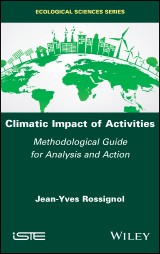Details

Climatic Impact of Activities
Methodological Guide for Analysis and Action1. Aufl.
|
139,99 € |
|
| Verlag: | Wiley |
| Format: | |
| Veröffentl.: | 15.01.2020 |
| ISBN/EAN: | 9781119695059 |
| Sprache: | englisch |
| Anzahl Seiten: | 240 |
DRM-geschütztes eBook, Sie benötigen z.B. Adobe Digital Editions und eine Adobe ID zum Lesen.
Beschreibungen
<P>Where the environment is concerned, regardless of scale, the logic of the Native American hummingbird which �does its part� should prevail. To act independently of others is indeed the sine qua non of the global shift towards a regenerative economy of humanity and ecosystems, expurgating the pervading pollution (particularly from oil use). Small- and medium-sized enterprises, which this book especially targets, do not need disproportionately-sized study facilities in order to reduce their impact on global warming.<P> <P>Climatic Impact of Activities provides valuable methodological and practical support for establishing a complete and reliable diagnosis of the greenhouse effect, and for planning the corresponding corrective actions. This book guides the reader step by step in developing an informed emissions assessment with realistic and advanced case studies, in full compliance with official methodological recommendations.<P>
<p>Foreword ix</p> <p>Preface xiii</p> <p>Acknowledgments xv</p> <p>Introduction xvii</p> <p><b>Chapter 1. Overview of the Scientific Basis for the Greenhouse Effect and Geocycles 1</b></p> <p>1.1. Greenhouse effect 1</p> <p>1.2. The additional criteria of the emissions in the atmosphere 3</p> <p>1.2.1. The carbon geocycle 3</p> <p>1.2.2. The water geocycle 9</p> <p>1.3. Answers to exercises in Chapter 1 11</p> <p><b>Chapter 2. General Methodology for Quantification of a Climate Footprint 15</b></p> <p>2.1. Description of the problem 15</p> <p>2.2. Identification of the greenhouse gases to be included 15</p> <p>2.3. Quantification of the impact of greenhouse gases on the climate: radiative forcing 17</p> <p>2.4. Quantification of the relative climate impact: the Global Warming Potential 18</p> <p>2.5. Climate impact of gases in relation to their quantity: the emission factor of greenhouse gases 23</p> <p>2.6. Impact of greenhouse gas emission processes on the climate: the emissions factor of any material 23</p> <p>2.7. Impact of an activity on the climate: generalization of the characterization of flows 25</p> <p>2.8. Answers to the exercises in Chapter 2 27</p> <p><b>Chapter 3. Quantification of the Climate Footprint of an Organization: Methodology of the Balance of Emissions 33</b></p> <p>3.1. The various methods 33</p> <p>3.2. The broad-spectrum greenhouse gas emission balance 34</p> <p>3.3. The system at hand: processes and flows 38</p> <p>3.4. Data harvesting 39</p> <p>3.5. The case of the regulatory greenhouse gas emission balance in France 40</p> <p>3.6. Answers to the exercises in Chapter 3 43</p> <p><b>Chapter 4. Calculation of Emissions 47</b></p> <p>4.1. Emissions due to the use of energy 47</p> <p>4.2. Other direct emissions (excluding energy) 49</p> <p>4.3. Emissions due to manufacturing of inputs 49</p> <p>4.4. Emissions due to transport of merchandise 50</p> <p>4.4.1. Road transport 50</p> <p>4.4.2. Non-road transport 61</p> <p>4.5. Emissions due to movements of people 61</p> <p>4.6. Emissions due to waste treatment 62</p> <p>4.7. Emissions due to the production of tangible assets 66</p> <p>4.8. Emissions due to the use of products 68</p> <p>4.9. Emissions due to the end of life of products 72</p> <p>4.10. Calculation of uncertainties 73</p> <p>4.10.1. Emissions due to the incineration of plastic waste (see section 6.1.3.7.3) 76</p> <p>4.10.2. Emissions due to transportation of sawdust supplies (see section 6.1.3.5.2) 77</p> <p>4.11. Answers to the exercises in Chapter 4 79</p> <p><b>Chapter 5. Results Analysis 81</b></p> <p>5.1. Recommended actions 81</p> <p>5.2. Interpreting balances 81</p> <p>5.3. Carbon dashboard 83</p> <p>5.4. Answer to the exercise in Chapter 5 84</p> <p><b>Chapter 6. Case Studies 85</b></p> <p>6.1. Case study 1: brickworks 86</p> <p>6.1.1. Description of the activity and challenge in the exercise 86</p> <p>6.1.2. Activity data and emissions factors 87</p> <p>6.1.3. Calculation of emissions 97</p> <p>6.1.4. Recap of the quantification of emissions 117</p> <p>6.1.5. Recommendations 118</p> <p>6.2. Case study 2: vineyard 126</p> <p>6.2.1. Description of the activity 126</p> <p>6.2.2. Challenge in this exercise 126</p> <p>6.2.3. Specifications about the activity and questions 127</p> <p>6.2.4. Activity data 127</p> <p>6.2.5. Answer to case study 2: winemaking industry 132</p> <p>6.3. Case study 3: factory for production of animal feed 137</p> <p>6.3.1. Description of the activity 137</p> <p>6.3.2. Challenge in this exercise 139</p> <p>6.3.3. Specific activity data 139</p> <p>6.3.4. Answer to case study 3: factory for production of animal feed 140</p> <p>Conclusion 163</p> <p><b>Appendices 165</b></p> <p>Appendix 1. For a Physical Economy 167</p> <p>Appendix 2. Explanation of the Calculation Methods for Emissions due to Transport of Merchandise 183</p> <p>Appendix 3. Accounting of Emissions due to the Production of Fixed Assets 191</p> <p>Appendix 4. Emissions Related to Journeys Made Between the Brickworks and Employees’ Places of Residence: Analysis of Sensitivity to Calculation Hypotheses (Case Study 1) 203</p> <p>References 209</p> <p>Index 217</p>
Jean-Yves Rossignol is an eco-engineer and interdisciplinary mediator. He pursues an ethical project through consulting and education with all types of organizations, and trains and assists companies in relation to the issue of climate.

















